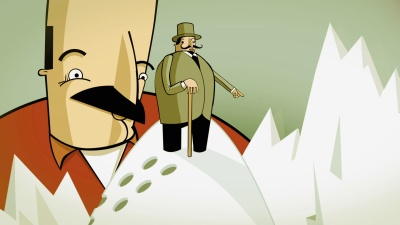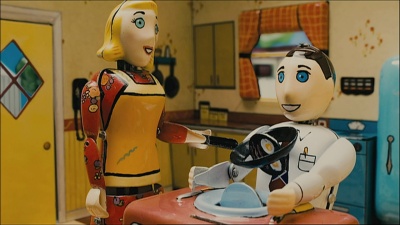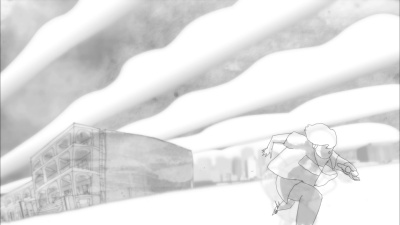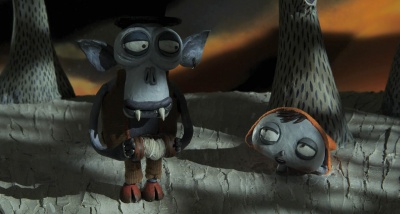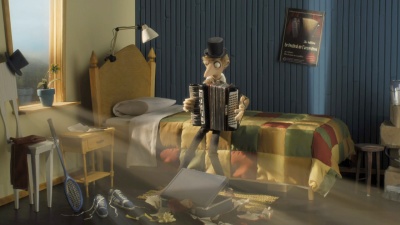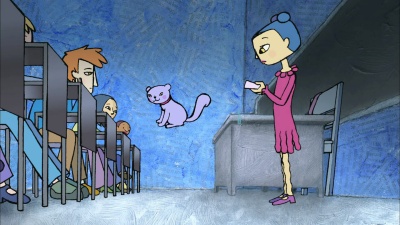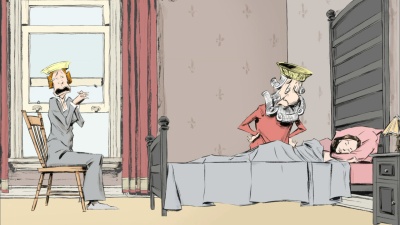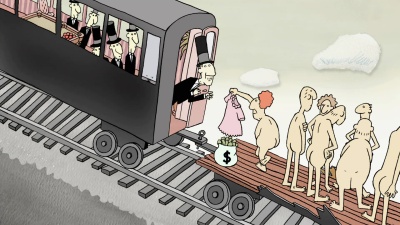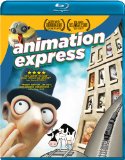| Reviews & Columns |
|
Reviews DVD TV on DVD Blu-ray 4K UHD International DVDs In Theaters Reviews by Studio Video Games Features Collector Series DVDs Easter Egg Database Interviews DVD Talk Radio Feature Articles Columns Anime Talk DVD Savant Horror DVDs The M.O.D. Squad Art House HD Talk Silent DVD
|
DVD Talk Forum |
|
|
| Resources |
|
DVD Price Search Customer Service #'s RCE Info Links |
|
Columns
|
|
|
Animation Express
Image // Unrated // June 8, 2010 // Region 0
List Price: $29.98 [Buy now and save at Amazon]
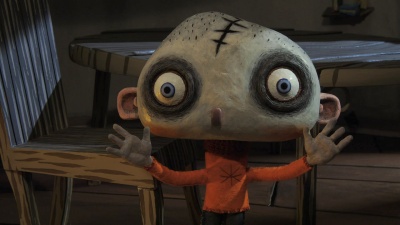 |
| Sainte Barbe |
Animation Express isn't aimed squarely at the younger crowd the way you might expect. It's not that these films are inappropriate for children, exactly; in fact, a number of them play marvelously to all ages. They're generally crafted with a more adult sensibility...even those that are appropriate for all ages aren't the least bit dumbed down, respecting the intelligence of these younger viewers. Tot to sound pretentious, but they're animated films, not cartoons. There is, however, some discussion of drugs, more than a couple of exposed derrieres, and the occasional cartoonishly undersized penis, and the menus are designed to help viewers navigate by subject matter if there happens to be a child in the room.
The approach to animation throughout this collection is wildly eclectic: stop-motion, time-lapse photography in which the camera is essentially what's being animated, pencil sketches, watercolors, computer graphics, Flash, rotoscoping, ink and paint... No one form dominates. No single sensibility overwhelms the set either: some films are whimsical and accessible, others aim for something more emotionally resonant, and others still are abstract and elliptical. These are films crafted with passion and explore what animation as an art form can accomplish. Steering away from the routine is rather the point and an essential part of the appeal of Animation Express. Many of these shorts could not exist in any other medium. That's as much of an overview as I can muster, really. Aside from being animated and having been funded at least in part by the NFB, there's little else these films have in common, and that eclectic bent is among Animation Express' greatest strengths.
Some of these films don't seem like anything I've seen before. Retouches starts with a few rough strokes of paint that dance and reshape themselves, morphing from a figure darting up an escalator to a runner bounding over hurdles. A brush running through long strands of hair twist into a forest. This is a beautiful, entrancing film, and it's one that could only be realized through the art of animation...it could not be reproduced in any other medium. How People Got Fire is one of several films that melds together several different animation techniques. The framing story of a child in a small village entranced by an older woman's stories is
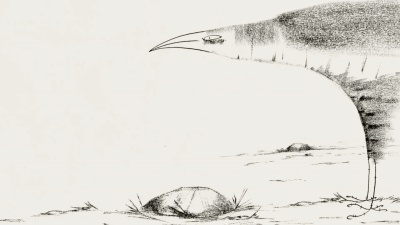 |
| How People Got Fire |
Rains, like quite a number of films throughout this collection, is devoid of any dialogue or narration. Its approach to storytelling relies entirely on its visuals and its atmospheric sound design, conveying the sense of claustrophobia in a bustling metropolis as rain pounds down from above...that even in a city teeming with millions of people, life can still feel cramped and rather isolated. Invasion of the Space Lobsters makes its own point about isolation and modern society, but it pulls that off with a more overtly satirical approach: a couple of helpful aliens are tormented because they learned to speak English through awkwardly written instruction manuals and impenetrable legalese. The idea's that speaking the same language doesn't mean we're necessarily going to be understood.
A number of these films have been lavished with awards and various nominations. The collection opens with The Danish Poet, one of several seemingly biographical stories featured throughout Animation Express and the winner of the 2007 Academy Award for Best Animated Short. It's the tale of a love that's fated to be, focusing on a poet named Kasper Jorgenson who travels to Norway to meet an author who deeply inspired him, and he stumbles upon a starcrossed romance along the way. There's a level of exaggeration that certainly benefits from being animated, and I'm kind of fascinated that so much setup is offered to tell the story of another love that exists almost in the margins. Cordell Barker's Runaway took home an audience prize at the Cannes Film Festival, and it's one of the most absurd, ridiculous, and dementedly fun shorts in the collection as passengers in a train toss everything they have -- including their clothes! -- in a furnace to make their way over a mountainous hill. Also set against the backdrop of a train is Madame Tutli-Putli, an Academy Award nominee and easily one of the most visually striking films in the set. There's an intensity
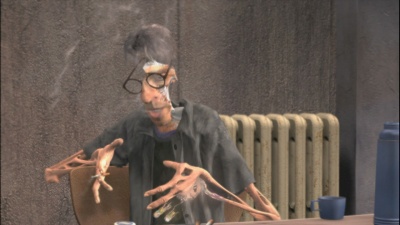 |
| Ryan |
It's difficult to continue to point to the standouts in this collection since most all of them are remarkable, really. I am particularly impressed by the two stop-motion animated pieces by Claude Barras and Cédric Louis, though: Sainte Barbe and Land of the Heads. Both films are infused with such an immediately distinctive style, so rich and so breathtakingly detailed. That keen eye and a penchant for the grotesque match Tim Burton as his creative peak. The cacklingly dark sense of humor immediately caught my attention, of course; Sainte Barbe is about death and honoring...letting go...of the past, while Land of the Heads decapitates a small army of hapless folks for a vain woman eager for a makeover. What I also love is that this isn't an invisible art. Even with the staggering amount of time
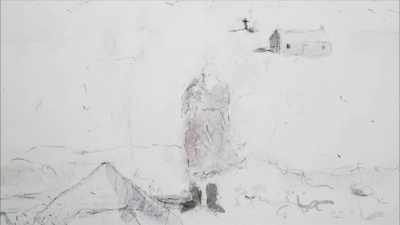 |
| The True Story of Sawney Beane |
Another favorite is Sleeping Betty with its striking storybook-inspired artwork and brilliant sense of humor. 60% of the Kids in the Hall lend their voices to films in this collection, including Dave Foley in Paradise. This is a case where the medium is the story: a grinning, carefree business man lets himself get caught up in a very mechanical routine, ignoring his wife and letting a lecherous coworker stomp all over him. The animation is executed with mechanized tin toys, and the sight of what happens to this poor fellow when his listless routine catches up with him -- his wife removed from her stub, and those now-empty gears still clacking and whirring away -- makes an immediate impression. Paradise couldn't have been realized in any other form.
I wouldn't consider all of the films in Animation Express to be successes, however. Pimp My Boat is a stale riff on -- and I'm sure this goes without saying -- Pimp My Ride. Even with a boat-pimping robot and a, um, cyclops at the end there, it's basically an obvious, one-note joke. I'll confess to not really getting the point of HA'Aki, which starts with a fairly faithful reproduction of a hockey game that quickly becomes more stylized...the play-by-play is ominous and distorted, and the players devolve into explosions of light and color barely recognizable as human. It's visually impressive, but I'm not really sure what it's trying to say. Most of these films do have something immediately intriguing about them, however, and it's an exceptionally compelling collection overall.
One of the very first DVDs I bought more than a decade ago was The World's Greatest Animation, another release distributed by Image Entertainment showcasing how powerful a medium for storytelling that animation can be. I'm thrilled that Image has seen fit to issue an even stronger collection on Blu-ray, drawing from the seemingly endless collection of extraordinary work from Canada's National Film Board. Simply put, Animation Express is essential viewing for anyone fascinated by the art of animation. Highly Recommended.
Video
The styles of animation featured throughout this collection are wildly eclectic, but their presentations are largely much the same: filling the screen at an aspect ratio of 1.78:1, encoded with AVC, and presented at 1080p24. A
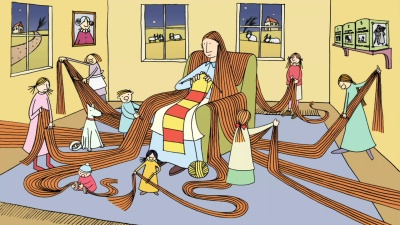 |
| The Danish Poet |
These shorts, by and large, look gorgeous in high definition. Even with the sheer volume of animation I've devoured in HD over the past few years, I'm still floored by the startling clarity and definition of such films as Engine 371 and Hungu, both boasting exceptionally well-defined linework and leagues above anything DVD could hope to reproduce. The stop-motion animation -- especially Sainte Barbe, The Land of Heads, and Madame Tutli-Putli -- is even more breathtaking. Again, the level of detail showcased here...its depth and dimensionality....eclipses anything DVD has to offer. This collection demands to be experienced in high-def.
A few of these shorts do appear to have been upscaled from standard definition sources, however. Paradise is clearly culled from a low resolution source and looks as if it's been oversharpened to try and compensate. Rains and Retouches both boast more of a DVD-like appearance as well...soft and lacking in definition and detail, though that works somewhat to Rains' benefit. A couple others had their post-production work fielded in HD -- the titles and credits -- but the body of the films themselves are not noticeably high definition, such as The True Story of Sawney Beane and Come Again in Spring.
One frustrating decision made in the authoring of this disc is that a number of the films are encoded twice: once in English and again with burned-in French subtitles. That's horrifically inefficient, and even with the expansive capacity of a BD-50 at its fingertips, placing more than four hours of video on a single disc is almost certainly going to result in the compression sputtering and stuttering. The artifacting isn't severe, but some of the linework isn't as clean as it ought to be upon close inspection, and the backgrounds occasionally do look blocky, especially whenever the camera pans up or down. It's disappointing to put on a film like Subservience that is so spectacularly crisp and detailed, to the point where I felt as if I could clearly discern each and every grain of sand, and yet the imagery in the background is noisy and unstable. If the mandate is that there had to be separate encodes with burned-in subtitles, this collection really should've been spread across two discs. There is some minor banding at times as well, but it isn't terribly distracting, and the presentations of these films are all but free of any speckling or wear. A few scattered flecks appear in Rains, and that's essentially it.
Those compression issues are disappointing but admittedly minor in the overall scheme of things, and I hope they don't dissuade anyone from exploring what is otherwise a spectacular collection of animation.
Audio
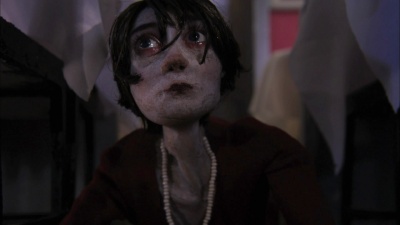 |
| Madame Tutli-Putli |
In keeping with the NFB's mission statement to embrace Canada's bilingual culture, these films are offered in both English and French. Subtitles for the deaf and hard of hearing have been provided in both languages as well.
Extras
The flipside of the packaging lists thirteen 'bonus shorts', among them the Academy Award-winning Ryan and The Danish Poet. Since they're presented alongside the other films without anything to noticeably set them apart from the rest, I'm not considering them extras in that sense. The only proper extras are a handful of trailers for other NFB collections: Stories and Destinies, Volatile Materials, Mindtravel, and Seven to See!. These run around seven minutes in total.
There are no commentaries, interviews, liner notes, or anything to put these 39 films in any sort of context. They're left to stand for themselves. It's worth noting that the menus allow these films to be browsed by subject matter, by title, or by filmmaker.
The Final Word
Though the word 'animation' may bring to mind towering robots and talking CG animals, it's as rich and expressive an artistic medium as any other. Animation Express doesn't pander to the junior set; no, this expansive collection of short subjects is aimed squarely at adults, brilliantly showcasing the power and artistry that animation has to offer. Highly Recommended.
Additional Screenshots
|
| Popular Reviews |
| Sponsored Links |
|
|
| Sponsored Links |
|
|
| Release List | Reviews | Shop | Newsletter | Forum | DVD Giveaways | Blu-Ray | Advertise |
|
Copyright 2024 DVDTalk.com All Rights Reserved. Legal Info, Privacy Policy, Terms of Use,
Manage Preferences,
Your Privacy Choices | |||||||









